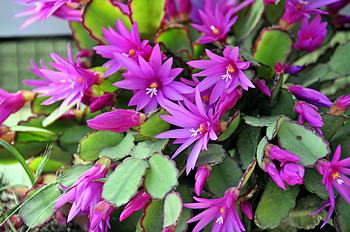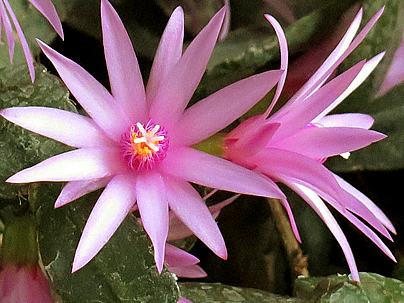The Rose Easter Cactus (Hatiora rosea) is a herbaceous, epiphytic, and floriferous plant, belonging to the cactus family and native to southern Brazil. It features succulent, cylindrical to flattened segments, with dark green color, often with rounded and reddish edges, adorned with small thorns. They initially grow upright and when they reach a certain length and weight, they become arched and pendulous.
As a result, older plants can have an interesting cascading effect. The flowers appear in spring, stimulated by the gradual increase in light exposure, specifically in October in the southern hemisphere and during Easter in the northern hemisphere. They are very beautiful and large, star-shaped, and are either axillary or terminal. The typical species has pink flowers, but there is a cultivar with red flowers. Hatiora rosea is one of the parents of the hybrid Hatiora × graeseri, widely known and marketed under the name “Easter Cactus.”

Plant it in pots, window boxes, and hanging baskets to enhance its pendulous effect. Ideal for decorating balconies, terraces, patios, living rooms, offices, and other areas protected from direct sunlight but well-lit. Following the latest trends, the Rose Easter Cactus is a popular choice for curious upside-down pots and vertical gardens.
In the garden, cultivate it on the forks of thick and rough-barked trees with evergreen canopies, adding sphagnum moss to the roots and securing them gently with natural materials like raffia, sisal, or cotton twine.
It should be grown in partial shade or abundant diffused light, in a substrate suitable for epiphytes, which means it should be light, airy, well-draining, and with good moisture-retaining capacity. Mixes designed for orchids, with a bit of sand and potting soil, are suitable for cultivation. It does not tolerate waterlogging and will rot quickly if overwatered. Avoid using a saucer under the pot, but water regularly. Fertilize from late winter with flowering-specific fertilizers, such as NPK 04.14.08 or bone meal with well-rotted manure. Maintain fertilization until mid-autumn.
The Rose Easter Cactus thrives in a subtropical climate. It can be propagated by taking cuttings of the segments and rooting them in a moist substrate. Remove the segments after flowering, without injuring them, by twisting them at the base to detach them. Like with other cactus species, let the segments scar for 24 hours in a cool, shaded place before planting. Plant 3 to 7 segments per pot for a fuller appearance.


